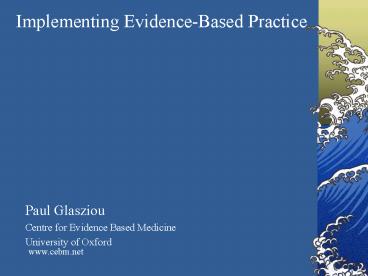Implementing EvidenceBased Practice - PowerPoint PPT Presentation
1 / 23
Title:
Implementing EvidenceBased Practice
Description:
between what is known and what is done. What are the 'gaps' between research and practice? ... Protocols in UK neurology units - 80% still recommend bed rest after LP ... – PowerPoint PPT presentation
Number of Views:75
Avg rating:3.0/5.0
Title: Implementing EvidenceBased Practice
1
Implementing Evidence-Based Practice
- Paul Glasziou
- Centre for Evidence Based Medicine
- University of Oxford
www.cebm.net
2
Knowledge Gaps between what is known and what is
done
- What are the gaps between research and
practice? - Why do such gaps exist?
- How can we close a specific gap?
- How can we close all gaps?
3
Knowledge Gaps between what is known and what is
done
- What gaps between research and practice are you
involved in?
4
The Epidemiology of Ignorancein Health Care
- What do we know about what we know?
- Prevalence Incidence
- Aetiology/Causation
- Prognosis
- Treatment
5
Is bed rest ever helpful?A systematic review of
trials
- 10 trials of bed rest after spinal puncture
- no change in headache with bed rest
- Increase in back pain
- Protocols in UK neurology units - 80 still
recommend bed rest after LP Serpell M, BMJ
1998316170910 - evidence of harm available for 17 years
preceding...
Allen, Glasziou, Del Mar. Lancet, 1999
6
Many Leaks from research practice
If 80 achieved at each stage then0.8 x 0.8 x
0.8 x 0.8 x 0.8 x 0.8 x 0.8 0.21
7
Another case of economy class
syndrome. Shouldnt everyone take an aspirin and
wear stockings?
What do you think about flight socks?
8
Knowledge Gaps between what is known and what is
done
- What gaps between research and practice are you
involved in? - Why does the gap exist?
- (list several possibles causes)
Not Organised
Aware Accept Target Doable Recall Agree
Done
7
6
5
4
3
2
1
0
9
Causes
1. Too much information 2. Too much
information 3. Too much information
10
JASPA(Journal associated score of personal
angst)
- J Are you ambivalent about renewing your JOURNAL
subscriptions? - A Do you feel ANGER towards prolific authors?
- S Do you ever use journals to help you SLEEP?
- P Are you surrounded by PILES of PERIODICALS?
- A Do you feel ANXIOUS when journals
arrive?YOUR SCORE? (0 TO 5)
0 (?liar) 1-3 (normal range) gt3 (sick at risk
for polythenia gravis and related conditions)
Modified from BMJ 19953111666-1668
11
Size of Medical Knowledge
- NLM MetaThesaurus
- 875,255 concepts
- 2.14 million concept names
- Diagnosis Pro
- 9,200 diseases
- 20,000 abnormalities (symptoms, signs, lab,
X-ray,) - 3,200 drugs (cf FDAs 18,283 products)
1 per day for 25 years
12
Rule 31 Review the World Literature
Fortnightly "Kill as Few Patients as Possible"
- Oscar London
13
And the information we need is widely scattered
Studies of BNP in MEDLINE Natriuretic Peptide
10,110 MeSH BNP 2,204 PubMed Clinical Queries
broad 799 narrow 82 Our systematic review Of
BNP accuracy for the Diagnosis of heart
failure 20 studies qualified Found in 16
journals
Age Ageing Am J Med Br Heart J BMJ
3 Circulation Clin Cardiol Clin Chem Acta Eur J
Heart Fail Hypertension JAMA J Card Fail J
Hypertens Lancet 3 N Engl J Med Rev Esp
Cardiol Rev Port Cardiol
14
Organising I systematic reviews - 20 done for
therapy
Alderson, 2005
15
Knowledge Gaps between what is known and what is
done
- What gaps between research and practice are you
involved in? - Why does the gap exist?
- What would you do to fix the gap?
Not Organised
Aware Accept Target Doable Recall Agree
Done
7
6
5
4
3
2
1
0
16
The Prognosis of Ignorance is Poor
17
Prevention Treatment
18
Where is your main activity?
Studies (primary research studies
sound unsound)
Systems (bottomline /- ref) Synopses (user
summary of research) Systematic Reviews
CATs (search appraise synthesis)
Glasziou, Haynes, EBM 2005
19
Just in Time learningInterns information
needs
- Setting 64 residents at 2 New Haven hospitals
- Method Interviewed after 401 consultations
- Questions
- Asked 280 questions (2 per 3 patients)
- Pursued an answer for 80 questions (29)
- Not pursued because
- Lack of time
- Forgot the question
- Sources of answers
- Textbooks (31), articles (21), consultants (17)
Green, Am J Med 2000
20
Just in Time learningThe EBM Approach to
Education
- Shift focus to current patient problems(just in
time education) - Relevant to YOUR practice
- Memorable and behaviour changed!
- Up to date
- Skills and resources for best current answers
21
Teaching EBM a systematic review of 23
controlled studies
- Integrated teaching
- Real patients
- Current problems
- Results in better
- Knowledge
- Skills
- Attitudes
- Behaviour
Coomarasamy, BMJ 20043291017
22
Treatment of Ignorance
Implications for practice Interactive workshops
can improve professional practice. Lectures alone
are unlikely to change professional practice
23
Dissemination and diffusionWhat do we know?
- Rogers work in rural sociology
- Greenhalgh T, et al. A systematic review of the
literature on diffusion, dissemination and
sustainability of innovations in health service
delivery and organisation. London, NHSSDO
Programme, 2004 - EPOC reviews































